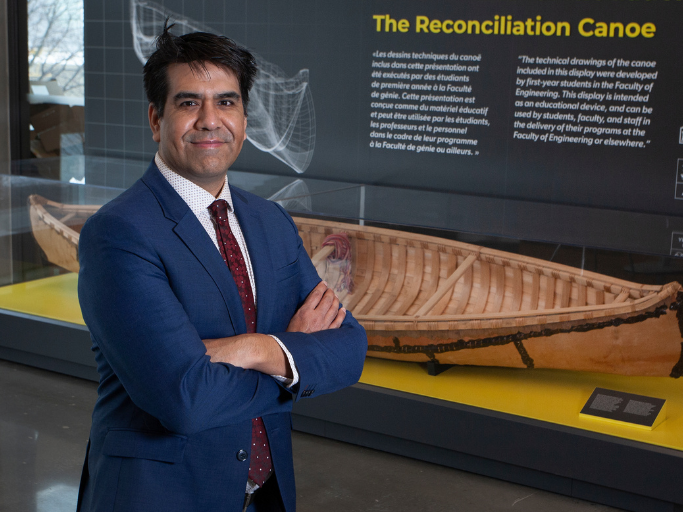During this year’s National Engineering Month, we hosted a uOttawa Innovates panel discussion where Darren Sutherland, Indigenous Community Engagement Officer at the University of Ottawa, sat down with Colin Rennie and Joseph Wabegijig, the leading duo at the Centre for Indigenous Community Infrastructure (CICI), to delve deeper into the project. Here are some highlights of this panel discussion.
Q1. Darren Sutherland: For those who are not super familiar with the Centre for Indigenous Community Infrastructure, which we love to call CICI, what is the Centre?
Colin Rennie: Let me go back a few years when we recognized at the Faculty of Engineering that a few professors were working with Indigenous communities on infrastructure issues, such as wastewater, water treatment and so on. We reflected on the fact that all these infrastructure issues are somewhat interrelated. So, we thought why not create a centre that would take a more integrated approach to infrastructure issues within Indigenous communities.
Q2. If you had an elevator pitch for the National Indigenous Climate Compass, what would you say about it?
Joseph Wabegijig: The National Indigenous Climate Compass is a web-based tool for Indigenous communities and their partners to identify climate risks and enable their community to be resilient in the face of climate adaptation.
Q3. Can you walk us through the initial thought process for reaching out to communities?
Joseph Wabegijig: I think the most important part of the process is ensuring user adoption, and that adoption continues to be that connection point for climate change adaptation, so that no community is left behind.
Q4. What sets the compass apart from other tools?
Colin Rennie: Similar platforms don’t include engagement with the communities themselves, which helps to find out specific aspects of climate change that are potentially hazardous and what risks the communities are facing. What we bring to the table is the aspect of hazard and risk mitigation.

“What we bring to the table is the aspect of hazard and risk mitigation.”
Colin Rennie
— Acting Director, Centre for Indigenous Community Infrastructure
Q5. Which are some of the communities that are involved with the Compass so far?
Joseph Wabegijig: We've been able to get in touch with a lot of different communities, with their tribal councils that span across the country. I’d say the furthest east so far has been Quebec, and we’ve had introductory conversations with people in the Yukon, in the Northwest Territories, in British Columbia, and throughout Ontario.
Q6. What were the initial responses? Is there anything that you were not expecting?
Colin Rennie: One thing that came out of the conversations was that we recognized the need for OCAP principles, i.e. ownership, control, access, and possession. So, one of the first things we did as part of this process was to develop a protocol or operating rules. This is something that was very important to learn right from the start because it’s kind of the heart of building the tool. It’s an example of how community involvement has changed our view of what the tool should be. During initial development, we worked closely with Indigenous Tech.ai, our industry partner.
OCAP® is a registered trademark of the First Nations Information Governance Centre (FNIGC)
Joseph Wabegijig: To add to Colin’s point, there is currently no nationally adopted online tool to serve as a baseline or model for how Indigenous communities can automate and simplify the process for research and OCAP principles.
Q7. How are you working with Indigenous Tech.ai?
Joseph Wabegijig: We were really engaged in a more technical AI-type relationship. So, we collaborated with them on the TD Ready Challenge project submission, and they were tremendous champions in terms of identifying the community’s perspective from a technology point of view, tied to OCAP principles that communities really value in research initiatives.
Colin Rennie: It’s important to mention that this is a majority-owned and controlled Indigenous company.
Q8. What are some of the insights from Indigenous communities regarding the Compass?
Joseph Wabegijig: Given that many communities have few resources to administer climate readiness and planning, much of the feedback received is a sense of relief because it will not only help them centralize information, but more importantly, help them plan faster and more effectively. They also really appreciate being part of the development process.
Colin Rennie: In general, discussions are focused on how and what the tool can help them with. For example, we talked about agriculture. I hadn't really thought of it as a potential driver of economic development, but if we can predict which crops will grow better in the coming years, this will help the communities be productive.
Q9. Are there any opportunities for students and researchers at the compass or CICI?
Colin Rennie: We've already built up quite a large team, but there’s room for those who want to engage with communities, work in climate science, work on the development of the tool itself from a technical point of view.
To conclude this edition of our uOttawa Innovates panel series, Darren Sutherland asked our speakers how industry or other stakeholders passionate about collaborating can get involved. Joseph Wabegijig said it best when he encouraged all those interested to reach out to them.
Whether you’re an industry partner, community partner, other stakeholder, government, or NGO, your expertise is welcome. The Compass is about fostering partnerships and communities at the national level and making sure we can be resilient in the face of climate change. The only way to do that is to work together.

“It's almost an aspect of reconciliation, if you think of it as bringing the community together, but also working on a specific solution to a problem we’re all facing.”
Joseph Wabegijig
— Coordinator, Centre for Indigenous Community Infrastructure


